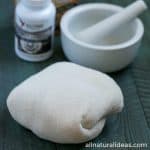Ever wonder why you feel lousy eating certain foods? Simple food sensitivity testing at home may help identify which foods you should avoid.

Runny nose? Watery eyes? Foggy brain? Sluggish? If you experience any of these symptoms after you eat something, they may be signs you have a food allergy or sensitivity.
To know for sure whether something your eating is triggering negative reactions, you’ll have to get a food sensitivity test. You can order a food sensitivity test online. But if you do order one online, expect to pay anywhere from $100 for a decent test to several hundred bucks for the most thorough one.
If you’re on a tight budget, though, you can do food sensitivity testing at home. More on that in a bit. First, let’s take a look at some facts…
Why am I sensitive to certain foods?
The advice to eat your veggies should be taken with a grain of salt (sea salt that is; it’s high in minerals and far better for your health than white table salt). Some veggies, and other foods for that matter, that are considered healthy may actually trigger food sensitivity symptoms.
An apple a day may keep the doctor away for one person. But for another person, maybe perhaps even you, an apple a day is enough to trigger sensitivity symptoms.
Nutritionists often advise people to eat a rainbow of items, meaning, eat lots of natural foods that are of different colors. Eat your greens like kale and broccoli. Eat red veggies like tomatoes and red peppers.
But any of these foods can trigger an autoimmune reaction. Even broccoli!
An autoimmune reaction means that your body recognizes a certain molecule(s) in the food as an invader. Your body then has a response to the particular proteins in the food.
Your immune system can be compromised by continued exposure to foods that trigger allergies or even the slightest sensitivity. So, it’s a good idea to find out if you are sensitive to things you eat regularly.

Food sensitivity vs food allergy
If you think your immune system may be compromised, it’s a good idea to have a food sensitivity test done. But many people don’t realize that a sensitivity is completely different from an allergy.
Food allergies and food sensitivities trigger completely different immune reactions. And food sensitivities don’t show up on a food allergy test.
It’s easy to see that you have a food allergy to, say, peanuts. Maybe you’re even deathly allergic to peanuts. Or if you have a strong allergy to seafood, and eat shrimp, maybe you would start wheezing and getting puffy.
Food sensitivities, though, are often more subtle, manifesting as less serious symptoms. But just because food sensitivity symptoms aren’t as potentially lethal as serious food allergies doesn’t mean they should be discounted as innocuous. Continuously eating foods or chemicals in foods that trigger sensitivity symptoms can weaken your immune system.
Testing for food sensitivity is trickier than testing for food allergies. After you eat something, a sensitivity can have a delayed reaction. We’re not talking half an hour here. We’re talking several days potentially after you eat an offending food!
Also, food sensitivities might not show up if you have a tiny bit of a certain food. But if you ate a huge portion, you may develop symptoms. This means that a food sensitivity test might not test positive for a sensitivity if the offending food was tested in a small amount.
Another problem with food sensitivity tests is food combining. Let’s say you’re sensitive to eggplant, tomatoes and potatoes (we’re picking on nightshades here because they can exacerbate inflammation in certain people).
You may have sensitivity symptoms if you ate all three foods in one sitting. But if you ate, say, only a small amount of tomatoes, no symptoms would present.
But food sensitivity testing could be an important tool in overall natural health. That’s because if you’re body is in a state of continuous inflammation, your cellular energy will be spent dealing with the inflammation instead of keeping you alert and thriving.
And food sensitivity testing has improved over the years. At the conclusion of this post, you’ll learn what the best food sensitivity test is…
Food sensitivity elimination diet
Food sensitivity test kits usually involve a skin prick test in the finger that draw a blood sample. Your blood sample is then sent to a lab. The lab analyzes your blood sample’s reaction to dozens of common foods.
Once you learn what your food sensitivities are, you can try a food sensitivity elimination diet. You can even bypass getting the blood test and do an elimination diet on your own to self-test for food sensitivities.
One of the most popular elimination diets is called the rotation diet. The rotation diet involves eating certain foods once every four days. The rationale behind this is that it prevents antigens (what your body perceives as toxins) from being stored in the body and manifesting as symptoms.
So let’s say that you ate bacon on Sunday and you noticed you got a headache shortly after eating bacon. If you can control for other health factors (not being hungover, or waiting until after noon to eat your first meal of the day), you can learn that you have a food sensitivity to bacon if you eat it four days later and noticed that you once again had a headache.
It may sound tragic to have a food sensitivity to bacon. However, doing an elimination diet can help you learn which foods to avoid.
The food sensitivity elimination diet allows you to eat a limiting number of foods in each major food category for those four days. For example, during the four days, your only meat would be, as illustrated in the example above, bacon.
The reason for this is that if you ate both bacon and chicken, you might not be sure which animal protein triggered a sensitivity immune reaction. You have to be able to single out the offending trigger.
If you’re freaking out about the possibility of being sensitive to pork, don’t worry. Most people don’t have pork sensitivity (although this blog post says that after you eat pork, your blood may suffer).
In fact, most sensitivities occur from gluten, soy, corn, peanuts and dairy. You can eliminate all these foods and then reintroduce them in a couple months one at a time to look for a sensitivity.
If you don’t have any symptoms after you reintroduce the foods, congrats! You can eat the offending food until your belly’s content. That is, of course, unless symptoms present again.
Elimination diets are difficult to stick with, though. That’s why it might be easier to get a food sensitivity test.

Food sensitivity testing at home
Don’t have the money to spend on a food sensitivity test? Or don’t feel like doing an elimination diet at home? Try doing a food sensitivity test at home.
The gist of food sensitivity testing at home involves taking your heart rate before you eat a certain food and then after. If your heart rate is significantly higher after eating a certain food, it may indicate you have a sensitivity.
How much higher of a heart rate would indicate a sensitivity? That’s up for debate. Some people say as little as 5 or 6 beats per minute is as little as it takes to indicate sensitivity.
Other people, however, discount this theory. They counter that eating anything will elicit a higher heart rate.
Still, it might be worth trying the pulse test at home. If your heart rate immediately is significantly higher, it could very well be an indication that a particular food is triggering an autoimmune reaction.
Want to try the pulse test method? Take your pulse one to two hours after eating your last meal. (Or after drinking red wine, although in the case of red wine, ignorance may be bliss; maybe it’s better not to know you have a sensitivity to red wine!)
Take your heart rate for a full minute and then record the heart rate. Then, eat only one type of food (or drink).
Chew it slowly for at least 30 seconds. Take your pulse while the food is still in your mouth. Do not swallow the morsel while taking your heart rate. Remember to take your pulse for a full minute.
After you record the pulse, do not swallow the food. Spit it out and rinse your mouth out with pure water.
If the difference in pulse is 6 beats per minute or more, you may have a food sensitivity, according to one popular method of testing.
Food sensitivity testing cost
One of the most comprehensive methods of food sensitivity testing is called the Mediator Release Test (MRT). According to the MRT food test site, this is the only sensitivity blood test that quantifies the degree of the inflammatory response in sensitivity pathways.
In other words, the MRT test not only tells you if you have a sensitivity, but to what degree of sensitivity you have. The MRT test allows for greater flexibility in your diet because if you stick with foods that trigger a very low reaction, you most likely won’t have serious symptoms.
But the problem with the MRT test is that it’s very expensive. It can cost several hundred dollars. Throw in consulting fees for a health professional and you can see that it can get very expensive to get a highly accurate food sensitivity test.
If you want to get a food sensitivity test that won’t break the bank, there are tests that run around $150. But these lower-end tests might not be able to tell you exactly to what degree sensitivity you may have in certain foods.
The bottom line: any food or drink, even what most would consider healthy can trigger food sensitivity symptoms. You can try testing foods on your own at home, or spring for a food sensitivity blood test.

Related reading: Is muscle testing legitimate for food testing?





